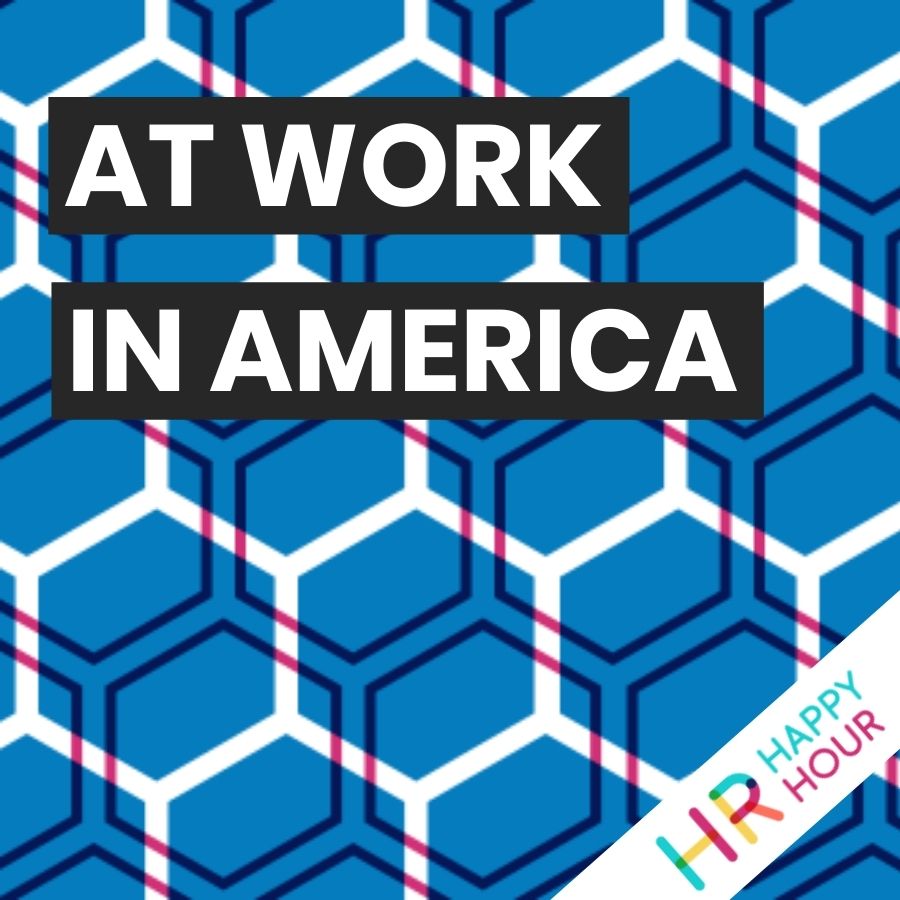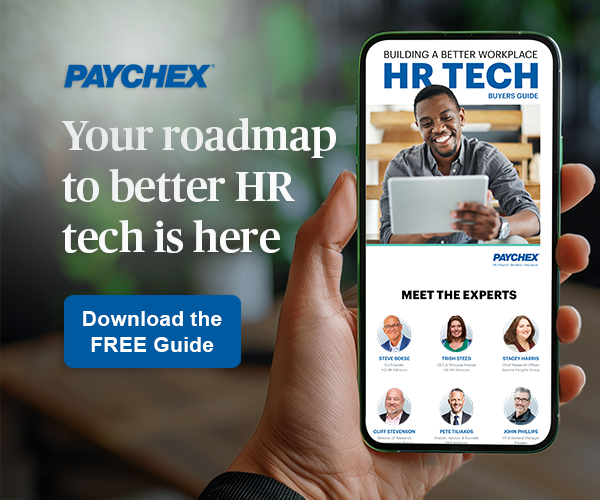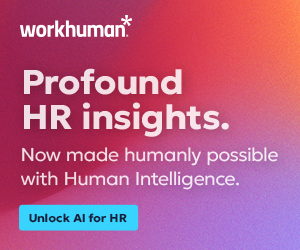Meet the Iconic Budweiser Clydesdales and the Brilliant People Behind Them
Hosted by

Steve Boese
Co-Founder and Chief Data Officer of H3 HR Advisors and Program Chair, HR Technology Conference

Trish Steed
Co- Founder and Chief Strategy Officer, H3 HR Advisors
About this episode
538 – Meet the Iconic Budweiser Clydesdales and the Brilliant People Behind Them
Hosts: Steve Boese, Trish Steed
Guest: Amy Trout, Ranch Manager at Warm Springs Ranch
This episode of At Work in America is sponsored by Paychex, one of the leading providers of HR, payroll, retirement, and insurance solutions for businesses of all sizes. The current business and hiring environment has redefined what it takes to succeed as an HR professional, requiring HR leaders to adapt and innovate at lightning speed to help their organizations remain competitive. Download the 2022 Paychex Pulse of HR report to discover the tools and tactics your peers are using to deliver on both HR and business objectives – faster and at scale – while still meeting the evolving needs of their employees. Visit payx.me/PHR2022 to download your copy, today.
This week, we met with Amy Trout from Warm Springs Ranch to learn more about the Budweiser Clydesdales and the team of people behind the brand.
– The education and skills needed to work with the Clydesdales
– Levels of preparation and training the horses go through before they can “work” on a hitch
– Budweiser Clydesdales origin
– Care of the horses from foal to retirement
– Internships and career positions with the famous Clydesdale team
– And so much more!!
Thank you, Amy, for joining the show today! Remember to subscribe to At Work in America wherever you get your podcasts.
Transcript follows:
Announcer 0:17
Welcome to At Work in America sponsored by Paychex. We welcome a wide and exceptionally impressive array of guests, business leaders, HR leaders, academics, practitioners, consultants and authors to talk about the most timely, relevant and challenging issues that are influencing the workplace today. At Work in America digs in behind the headlines and trends to the stories of real people making a difference in the world of work. And now here are your hosts Steve Boese and Trish Steed.
Steve 0:50
Welcome to the show today Trish, we have an amazing show today. We are we’re gonna get to all the details in a second. We’re on location at a very special place and we’re about to welcome a very special guest to the At Work in America podcast. Trish, I’m super excited.
Trish 1:06
I am too! I love when we get to go on site and do field trips. And this I think is going to shape up to be our best yet!
Steve 1:14
Our guest even gave us beverages, which is incredible. And so that is already my favorite show of the year. But first before, I’m teasing everything before we get to the show, let’s thank our friends at Paychex of course. This episode of At Work in America is sponsored by Paychex, one of the leading providers of HR, payroll, retirement and insurance solutions for businesses of all sizes. The current business and hiring environment has redefined what it takes to succeed as an HR professional, require HR leaders to adapt and innovate at lightning speed to help their organizations remain competitive. You can download the 2022 Paychex pulse of HR report to discover the tools and tactics your peers are using to deliver on both HR and business objectives faster and at scale, while still meeting the evolving needs of your employees. You can visit payx.me/phr2022 to download your copy today. And thanks of course to our friends at Paychex.
Trish 2:08
Absolutely. It’s a great report. Have you read it?
Steve 2:11
It is good and I read it twice.
Trish 2:14
Well, that’s good. No, everyone should get that. It’s always good to have a nice free resource.
Steve 2:18
Yeah, absolutely. So let’s get on to the show. We are at Warm Springs Ranch. I don’t know the name of the city, but we’re in Missouri.
Trish 2:28
Is this officially Boonville? We in Boonville, Missouri, so just for anyone who’s not familiar with it. So if you think center of Missouri, which is pretty close to center of the country, we’re very close to the center of everything right now.
Steve 2:40
I would say we’re in heartland and we’re welcoming our guest who is with us in person, Amy Trout. She’s the Ranch Manager at Warm Springs Ranch. Amy, how are you today?
Amy Trout 2:49
I’m awesome. Thanks for coming in. This is gonna be so much fun!
Steve 2:52
It is so great to see you. Thank you for having us and hosting us. For folks who may not know please tell us what Warm Springs Ranch is and a little bit more about what you do here.
Amy Trout 3:03
Well, Warm Springs Ranch is the home of the Budweiser Clydesdales. So literally, this is where it all began. This is where we take the mares, the stallions, all the babies are born here. The training takes place here. So if you’re a Budweiser Clydesdale fan, this is a must stop.
Steve 3:20
It’s absolutely iconic, right? I mean, there’s no person in America or probably pretty much anywhere in the modern world who is not familiar with Budweiser Clydesdales.
Amy Trout 3:31
You know, the horses are just iconic. People recognize them no matter where we go. But I would say that in Missouri, St. Louis, especially like there’s definitely a hometown feel about the Clydesdales. The locals take a lot of pride in the horses. But it’s always fun to have visitors from out of state and all over the world come here to see them.
Steve 3:50
Yeah, so just a little backstory of why we’re here the show. Six or eight weeks ago, something like that, I was just reading the news like I do on my computer every morning. Just thinking about coming up with ideas, either for this show or for some of the other things we do. And I read this really, really cool feature on business insider.com, about someone who was involved with the Clydesdales, and I read about this person and her job, and I’m thinking, wow, that’s really cool. So I contacted Karen, our show producer and Chief Customer Officer extraordinaire, and I said, “Don’t you know someone who is involved with the Clydesdales?” And she said, Oh, yes, that’s my friend, Amy. Oh, I said, this must be a show.
Steve 3:50
It’s destiny, that’s right. Yeah, for sure. I was just I think that too, if you think about the Clydesdales, and the ability to actually like come see them, not just to do a show, but I mean, it just like everything made sense to come to this and to really learn about what it takes to work for an organization like Anheuser Busch, what it takes to work in a role like this. This is different than anything we’ve ever heard anywhere else.
Steve 4:56
So maybe tell us a little bit about the job and what does it take to kind of run a place like this and get the teams of Clydesdales ready for all the things that they do around the world.
Amy Trout 4:56
So this is a 350 acre ranch. And there is a lot of moving parts of this. So not only do we have to worry about taking care of the pastures and the fence and all of the property, but we also have about 75 horses give or take at any given time. We also are responsible for all the breeding and there’s a lot of thought that goes into the breeding process, because you’re thinking about what mares and stallions might pair up the best to give you the most optimum offspring and make that beautiful eight horse hitch one day. And then there’s the actual, you know, nursing the mare through her pregnancy, delivering the foal, raising the foal, and then training, the whole, I mean, it’s just there’s so many moving parts of this operation, it’s really mind boggling. And then on top of that, we also are open to the public. So we have tours here. So we have to always be ready to entertain our guests and make sure they have a good experience. So it’s not just wearing one hat here. It’s wearing multiple hats all day long and switching them out throughout the day. Yeah, it’s pretty cool. I wouldn’t want to be anywhere else though.
Trish 6:05
So maybe like let’s break that down. That’s a lot to sort of unpack. So when you think about just the parts of your job, maybe there are not as public facing? Right. You talked a lot about just the understanding of horses, understanding from before birth, right. All the way through getting them to be working on a hitch. What’s your background? What got you into a role like this? And further than that? What would someone who may be interested in a role like this? Is that different today? Maybe then what you went through?
Amy Trout 6:35
Sure. Well, my background is I grew up in Virginia, and my family had a small farm, we did have some draft horses, we had some goats and lambs and all kinds of critters. So I always knew I wanted to work with animals. But we didn’t have anything fancy, like what you see here today. I mean, my dad worked the fields with the horses. And so I grew up with a passion for animals. I went to North Dakota State University, and I got my degree in animal science. And I have a minor in zoology. And so when I first left college, I mean, I was broke, I just wanted to get a teaching position in Virginia, and I was agriculture for two years at a high school in Virginia. So I was the FFA advisor and did all that kind of fun stuff with the kids. And then I just realized that my passion was really working hands on with animals. That’s what I wanted to do.
Amy Trout 7:24
And so I started sending my resume out to zoos, as well as Anheuser-Busch. And I said, here’s my resume, if you think, you know, I might be a good fit, call me and Budweiser call. Wow. And so they flew me to St. Louis the next week for an interview. And I have the job before I finished my second year of teaching. And so I told the bosses in St. Louis, that I was, you know, obligated to finish up this. And they said, Absolutely, yes, you do that. And then we want you to start so actually, this month, I hit my 20 year anniversary with the Clydesdales. So many years ago, I started with the San Antonio hitch in Chicago, Illinois, doing a Fourth of July parade. That was my very first day on the job. Right? Go big or go home.
Steve 8:11
I think I’m not exaggerating to say this is really a big, huge global company, huge global brands, very big, prominent part of their brand. I mean, maybe the people who are responsible for making the beverages probably, you know, they’re they have a pretty big job too. What you guys are doing here at the ranch, preparing these horses for that public facing. Well, it’s a very important part of what I’ve seen.
Amy Trout 8:35
Yeah, yeah, we are. We are the face of Budweiser and Anheuser-Busch. And, you know, you think about the great commercials we’ve done over the years. I mean, who doesn’t love the puppy? And, you know, all the good ones. There’s so many it’s hard.
Steve 8:48
The 911 commercial.
Steve 8:51
I watch it today and still get a tear in my eye.
Trish 8:54
I think with the Clydesdales, too, though, it brings you in as a child. Now growing up in St. Louis, I didn’t realize at the time, but back then I don’t even know if it still happens. But if you went to the St. Louis Cardinals baseball game, you know, there was a time where the the Clydesdales would come in. And it was just you get this feeling. It’s like this feeling of love for your city for the team for Anheuser-Busch, the whole thing, right. And so as you grow up, even if you’re not old enough to be a beer drinker, it’s something that connects you to Anheuser-Busch from a very young age. So I don’t know if that’s an intentional thing, or if that just kind of diverged from it.
Amy Trout 9:29
It has worked. I don’t know if it was intentional or not, you know, the Clydesdales itself wasn’t really intentional. You know, the whole premise of the Clydesdales started back in 1933 when prohibition was being repealed and, and so, you know, the president of the company was gifted a six horse hitch of Clydesdales from son, Gussy Bush, who started Grant’s Farm. As a gift and you know, who knew that that six horse hitch as a gift to celebrate the repeal of prohibition would turn into the greatest marketing story in American history. And next year, we’re going to be celebrating 90 years with the Clydesdales that this has been going on. So I mean, for just the like a little prezi turning into something so significant is pretty awesome.
Trish 10:15
That’s amazing. Now, do you have other animals here at this location? Or is this Clydesdales only?
Amy Trout 10:20
Just the bald eagle you saw this morning.
Trish 10:24
Really for anyone listening, like we arrived here this morning, we see a bald eagle as soon as we step out of the car and then we come right in and before we sit down to start doing this, you immediately took us over to see a brand new, born in March foal, right which I’ve never seen anything certainly not a Clydesdale, up that close and we were able to touch it and pet it and hug it.
Steve 10:44
It was like a little mini Clydesdale!
Trish 10:48
It’s overwhelming.
Steve 10:49
Most of us are familiar with the Clydesdales from advertising and maybe seeing him at events or ballgames or something but you only see the full the full grown horses, right? Just to take away that they must start at a smaller size at some point. And they said had never seen one that was a gigantic
Amy Trout 11:06
They’re 150 pounds to start. And they grow tremendously fast, because there’ll be close to 1000 pounds at one year of age. So that’s putting on a lot of weight in a very short period of time. They grow tremendously fast. And that’s another part of the job when we talk about all the different hats that you wear, just the nutritional component and making sure that each horse is like receiving the optimum nutrition to like reach that gross that we want and keep them healthy. I mean, there’s a lot of moving parts of this job.
Trish 11:35
Now with things like that. Do you have training that Anheuser-Busch provides on being able to stay current on some of those maybe new trends and nutrition for the horses and things like that. So you also do on your own?
Amy Trout 11:47
One of the things that we’ve done in the last 10 years is we partnered with Purina. Purina is based just outside of St. Louis. And the great thing about Purina is you know, they’ve been making horse feed as long as we’ve been brewing beer, and we’ve never worked together before. And about seven years ago, I was stationed at Grant’s Farm in St. Louis. And we had a few nutritional issues. And I reached out to some colleagues at Purina and they actually showed up at Grant’s Farm, they put the hands on the horses and like kind of went through the diets with me. And we were able to make some changes and saw some massive improvements. And just those couple horses. So, you know, we saw the writing was on the wall that hey, this is what we need to be doing with all of our horses. So in a very short order, we switched the entire herd to Purina fees. And now there are Purina nutritional experts, these guys have PhDs in nutrition, they come out here usually once a month or whatever I need them. And they’ll actually go through the herd with us offer suggestions keep us up to date with the most the newest technology and animal feeds. And so it’s great to have a good partner like that on the nutrition side.
Steve 12:50
Yeah, that’s awesome. Amy, we talked about it’s a 350 acre facility is about 75 horses here at any given time, huge, beautiful grounds, by the way, so maybe could tell us a little bit about just the, the staff that you have here you have must have a lot of different roles. I don’t know how many people you know, out there, get into all the specifics. And there if you don’t want to, but just tell us a little bit about what it takes operationally and the kinds of folks you have also out here on the team here at the ranch.
Amy Trout 13:16
So I have seven full time staff here. And the full time staff consists of myself and then I have two assistants, one that focuses on the reproductive side, one that focuses on the training side, and then everyone else just does everything just kind of crosses over. We also have a tour department here with when we have a supervisor that’s a full time person. And then we hire upwards of 20 Part time staff to be tour guides, course holders, tractor drivers, we have jobs, we have some ladies that just work in the gift shop. You know, but we have we work closely with Mizzou, so we do get a lot of college students that want to come and work this summer, but then we lose them when they go back to class.
Steve 13:56
We’re probably what 15 miles from the University of Missouri?
Amy Trout 14:00
Yes. But all of our jobs are posted at Buschjobs.com. So if anyone’s interested that is definitely the place to go and apply and we do have openings right now.
Trish 14:10
Do you have summer internships as well if someone for example, if they were wanting to go into this line of work, and maybe they’re currently studying whether it’s Animal Science, zoology to do internships with college?
Amy Trout 14:22
Yes, we actually have two internship positions that are actually paid positions. And what we do is we actually partner two individuals up with the traveling road hitches and so they actually get to travel all summer with the hitch and see what see what traveling across the country is like and let me tell you, it’s like traveling with the equine rockstars. Okay, yeah, like when you roll into town with the semis, and they’re beautiful, everybody wants to meet you and, you know, meet the horses and tell you the best places to eat and go see this and go do that. So traveling with a hitch is fantastic. And so these interns get a chance to do that. And then at the end we can decide if you know we Want to invite them back for a full time position, maybe it’s a great fit. And maybe they’re like, so it’s fun, but I want to do something else. But it’s a great learning experience. In the future. We’re actually hoping to expand on that. And maybe we’ll have some internship programs here at the ranch. So that’ll be really big. So yeah, stay tuned, that may be coming.
Trish 15:17
You’ll have to let us know if you do that. So we can like help spread the word. I wanted to maybe take it a little different direction. We’ve done other shows, some involving animals. And my curiosity would be we talk a lot about, you know, you have the East Coast hitch that is based out of this location. Can you talk a little bit about the work that the animals do, because I think that, you know, we think a lot about the work that the people do, but maybe talk about the training that the animals have to go through and what their experience of working is like.
Amy Trout 15:47
So what happens is when when the babies are born, they they’re with their moms until they’re six months of age, when they’re six months old, they get weaned, so that means they’re separated from their moms. And that’s when school begins. Because up until that point, they’re just kind of kicked out in the pasture with mom run around with their buddies, they don’t have a care in the world. So what happens is six months of ages will load the little guys on a trailer. And we actually send them two and a half hours to St. Louis, and they get off at Grant’s Farm. And that’s the prep school for the Clydesdales. So the things that they’ll learn there is like how to stand for the farrier, the vet, how to load on and off the trailer, how you know all the social graces and being in St. Louis, you get to hear the sights and the sounds of the city and planes and trains. And all those things are great to desensitize the horses too. So as they grow and mature, and when they hit about three and a half years of age, they’ll take another two and a half trailer ride our trail right back here to Warm Springs Ranch. And by that time, these guys should be about 1500 to 1700 pounds. They’re physically big enough, they’re mentally mature enough to start handling being harnessed and starting to pull the wagon.
Amy Trout 16:51
So at that point, we’ll bring him back here and we’ll put the harness on him. Now they’ve already been trained to do that. So they should stand perfectly, why we put all the gear on him. And then we’ll partner him up with an older, more mature horse that’s already grown to drive. And we’ll put them on a sled. And a lot of people ask, Well, why do you start them on a sled? Well, the sled has a lot of drag to it. So if it’s kind of spooks them a little bit, they’re not gonna run off. Yeah, sure, partnered with a 2000 pound horse that knows better. So they kind of graduate up to a rubber tired wagon, and then we will add two more horses and they’ll be a four horse hitch and then a six horse edge than a eight horse edge. And so we actually teach the horses how to drive in that order. We also teach the humans how to drive.
Steve 17:31
I was wondering about the person sitting on top of that wagon sort of driving, is that the right word drive?
Amy Trout 17:37
Yes, and we teach the human drivers at the same time because like, if you were in a room of 500 people, and you said raise your hand if you know how to drive an eight horse hitch, how many people find them, so we have to train them ourselves. And so the the humans will learn right along with the young horses. And so that’s kind of cool. So let’s spend a year here driving and then at that point, they graduate and now it’s like the NFL Draft, they’re up for hitch selection. And then the supervisors of the hitches will get together and it’ll be like, Okay, I want this one. I want that one. I can retire this one.
Trish 18:08
What’s the skills that a horse really look for to be a good member of the eight horse team?
Amy Trout 18:15
Well, so each position of the team is different. It’s no different than playing sports. You know, each position of the baseball team has different skills, right? Okay, so our real horses that are closest to the wagon, our biggest, strongest guys, they’re pulling all the way. The horses that are way out in the lead, those are smaller, they’re fancier, they got a lot of action, they pick their heads up, they’re fancy, but they pull the weight. So they’re all for show.
Trish 18:41
Kind of like Steve Boese!
Steve 18:44
It’s cool, just here for good looks.
Amy Trout 18:47
The East Coast hitch calls, and they need a big strong wheel horse. And all we have right now are smaller lead horses, well, that’s not going to be a good fit. So we got to find the right fit for the right hitch. So there’s a lot that goes into that.
Trish 19:00
And I see that’s fascinating. I would just think that all eight would be pretty similar. Yeah, you know, interesting. What about your drivers, what kind of skills will make for a good driver?
Amy Trout 19:10
Patience, number one. And you have to be able to react very quickly, because if you think about when you’re sitting on the wagon, the lead horse could be upwards of 35 to 40 feet away from you. So if they turned, you have a lot of slack in those lines. And so you have to be pretty quick on your feet and be able to adjust your lines, bring those horses back in line, and also keep everyone going. I mean, they they have minds of their own. So you do you know, you really have to be able to pay attention to all the horses and anticipate problems. You know, I remember doing the Macy’s Day Parade in New York City. Gosh, this was years ago, and somehow hitch got out with a hitch got out order and they had to put a big balloon in front of us. And I thought to myself, but this is gonna be really awesome that this huge balloon goes By the horses, but just like it’s seeing the problems and anticipating what could happen.
Trish 20:05
So what about you? Because you are so customer and public facing? Do you all regardless of what your job is, do you have a lot of training that you go through? I mean, obviously, you have to have skills that make you good for the public.
Amy Trout 20:19
There’s a lot of on the job training. And I think this goes for just about any job. There’s, for us, there’s the right way, the wrong way and the Budweiser way. And there’s only one way to do things here. So you know, you could come from a horse farm and have all the greatest horse experience in the world, but we have our own way of doing things. So a lot of it really is on the job training and learning how we do things. I mean, you know, next year, again, 90 years, so we’ve been there, done that wrote about it. So we’ve got a pretty good handle on what works for us. But hey, we were open minded to learn something new.
Steve 20:52
Here’s a question I had, which is sort of just applied stereotype question, which is, look, they’re so iconic, they’re everywhere. But I gotta believe like, the team here plus, like the marketing team, etc. Communications, wants to sort of be careful, a little bit like, you probably can’t just say yes to every time someone rings up and says, Hey, can the Clydesdale show up? Here are their process go about saying like, Hey, this is what the teams will do? You will out there.
Amy Trout 21:18
So, from Anheuser-Busch corporate perspective, we are represent, we represent the Budweiser brand as well as Anheuser-Busch. But the Budweiser brand has big sponsorships, like Major League Baseball is one of them. We do a lot of military things. So if there is like the all star baseball game coming up, and Budweiser is a big sponsor, well, we’re gonna be there. Yeah, sure. You know, if the all star baseball game was held at a stadium that wasn’t a Budweiser stadium, like, I’d be there for that, you know, so everything revolves around Budweiser beer and how we can support the brand. But in a nutshell, how it works outside of those big corporate events, is we go through our local Budweiser wholesalers. So whenever the local Budweiser wholesaler that services your area where you go to your grocery store, buy your beer, those folks will host us. And so if we were going to be in, let’s say, Sedalia, and we’re going to be there for the State Fair, you know, like it would be the local wholesalers that would be hosting us for that event. So those are the folks that put in the request downtown to the the headquarters in St. Louis. And we have a full time person that that’s all they do is just schedule, they just figure out the logistics of where we’re going and how we’re getting there.
Trish 22:29
That’s got to be really complex. I would imagine, again, talking about transporting, not just the horses but people too.
Amy Trout 22:36
Lining up hotels and making sure the horses have feed and hay at every location. And, you know, it is a huge undertaking, just moving the horses from point A to point B.
Steve 22:46
Are there any like international engagements as well?
Amy Trout 22:50
In 2014, I took four horses to China to celebrate the Chinese New Year, that was the year of the horse. And so behind the scenes, we had this crazy plan of how we’re gonna get him over there. And, you know, we ended up flying him over there via a Chinese cargo plane. And so I’m gonna go chose our trip. We traveled the distance equivalent of like, Maine to Miami, like that’s how far we traveled in China. So it was a tremendous undertaking and like what a crazy place to visit and you know, in these folks had never seen a Clydesdale before. So like, what an impact the horses made on that culture was amazing.
Trish 23:34
We’ve been to China several times. Yeah, for work as well. So yeah, it’s a very difficult match.
Steve 23:38
I remember our time flying business class for me again, so cool.
Trish 23:48
Two part question then. So could you maybe talk about where the various hitches are located to start? And then when you think about travel, like do they have certain should they do certain travel requirements, feel what they’re accustomed to?
Amy Trout 24:03
Absolutely. So the three hitches are the East Coast hitch base right here at Warm Springs Ranch or West Coast hitches set a Fort Collins, Colorado, we have a brewery there. And then our third hitches the St. Louis hitch that are right downtown at the brewery.
Trish 24:15
So obviously, I mean, you mentioned they’re on a cargo plane, but I’m imagining it has to be air conditioned or like are there certain things that they require to make them comfortable to it’s hard for us to travel, right and work in Asia, for example.
Amy Trout 24:29
So traveling with the Clydesdales is really interesting because we have three semis that transport the horses around the country and all the employees have to have a class a CDL to drive the horses around. We don’t contract that out so I have mine everyone that works here has a class a CDL. So we have to drive the trucks ourselves which that’s another whole skill set. So the horses travel six horses in one trailer, four horses in the next and then we have the wagon and the harness in the third truck. So each horse stands in and just sort of a tie style. So they have like a little bar for their chest and a little bar behind the rear so they can lean forward and backwards, but they can’t really move around too terribly much. We can hang hay bags in there for them. The trailers are all air ride very, very nice, very smooth. Each horse has an individual fan mounted above them. So if we get stuck in traffic, because of an accident, or you know, instruction or whatever, we can turn the generator on and make sure the horses have air moving across them. Now some of our restrictions are is that we don’t travel more than 500 miles a day. So there’s a lot of places that will just drive horses cross country and never stopped. But that’s not our own.
Amy Trout 25:39
So we stop every 500 miles and the horses get out, they spend the night they get downtime before they get back on the trailer and travel the next day. And we stop every two hours and check on the horses so they can get water if they need it, we can give them more hey, we actually have video cameras installed in the tracks as well. And so the horses can, the horses can be on camera the whole time. So the drivers can see if they had to brake suddenly, we can see you know if there’s any issues if we need to stop or if everyone’s okay. You know, when my when I first started with Budweiser, my family came out to visit me. And I was you know, shown on the show. I was like, you know, we have monitors in the track. So the, you know, the we have TV monitors. So you know, we can watch the horses and my grandmother didn’t understand. And she goes, what do you suppose the horses watch?
Steve 26:29
So last question for me at which we talked a little bit about the beginning, right, the following process and some of the early training. And then they come back to the ranch, you know, to sort of learn how to do the hitch, sometimes about sort of the sort of the mature working years and then maybe I don’t know that the retirement year of a Clydesdale.
Amy Trout 26:49
So the horses would graduate here as five years. And they take their place on the hitch at five and then we would retire them at about 15. So that gives them 10 years of active duty on the hitch. And then most of these horses will live into their early to mid 20s. So that would give them approximately 10 years of retirement. Now we have some horses that we keep on hand, particularly at Grant’s Farm that are retired and they just stand you know, and meet and greet guests.
Steve 27:17
Yeah, sure. Sure. Brand Ambassador. Yeah.
Amy Trout 27:20
So the horses retire, they still have a job. Yeah, nice, very easy job, but still a job. And then we also use some of those horses when we do film commercials. And so it’s nice to have those extra geldings on hand if we need to send some horses to California to shoot the next commercial. So just because they’re retired doesn’t mean we don’t use them anymore. Now, are they out plowing the back 40? No. Right, they got a pretty cushy life.
Steve 27:44
Yeah, I’m gonna say it probably worked hard for 10 plus years, it’s yeah, they get they get to have the ones that play football and have fun.
Trish 27:52
Training. Yeah, seems like a whole nother job. So awesome.
Steve 27:57
So Okay, last thing, then we’re done. Folks who want to come out and visit and say hello, see some of the horses get to maybe do see some of the things we’re gonna see today.
Amy Trout 28:07
Warm Springs ranch.com. You want to book your tour in advance and make your reservations. We’ve got packages for everyone, we actually have general walking tours that started as little as $15. We have VIP tours where you can go out on a tractor and wagon and see the horses up close in the pastures. And that’s what we’re going to do a little bit. And, and then we also have cool afternoon parties where if you’re celebrating a birthday or an anniversary, or just want to get together with your friends for a happy hour, we have those available in the afternoons. Over the holidays, we’re going to be open for the holiday lights. And this place is going to be absolutely gorgeous with Christmas decorations. And so be looking for that on our website as well. So that’ll start the day after Thanksgiving and roll through Christmas. So we’ve got a lot of exciting things coming up for the end of the year. So definitely come visit us.
Trish 28:54
That’s good. Now I know obviously in St. Louis, they can you know see the see the Clydesdales. They can go to Anheuser-Busch, there’s lots of activities there. What about your Fort Collins location? Do they have similar public facing abilities?
Amy Trout 29:08
It’s not all the time because the horses are traveling there. And so when the horses are out on the road, it is not open. But when the horses are home, you can check it out. So just go to their local website for Fort Collins. And you can find out when the hitch is going to be home.
Steve 29:23
Well, Amy, thank you so much for your hospitality. Thank everyone on the team here at Warm Springs Ranch everybody,
Trish 29:28
We have to say I’m drinking a Bud Light Lime..
Steve 29:31
Right? So that the finest American beverages that are made.
Trish 29:38
Growing up in St. Louis, like there’s no you just know this is the beer that you’re going to like and so you go somewhere else and someone’s you know, like, Oh, we don’t drink. I’m like, What are you crazy?
Steve 29:47
There’s no argument about it at all. So you won’t even debate it. Amy, thank you. One of the coolest jobs ever. That’s really part of the fun of what we’re doing here At Work in America. Learning about a cool, interesting fun job. Yeah, so please do come on out to Warm Springs Ranch if you can, check out buschjobs.com for getting involved in this and thanks so much and I can’t wait to go see some more horses.
Steve 30:16
Thank you Amy Trout. Thank you Trish. Great to see you. Thanks for this. Thanks to Karen for arranging this. That’s right, she’s over there and then inside of the room, she did a great job here so Okay, great show thanks to our friends at Paychex as well. Thanks for listening to the At Work in American show. Remember to subscribe wherever you get your podcasts and we will see you next time.
Transcribed by https://otter.ai
Talk to us
If you want to know more about any aspect of HR Happy Hour Media Network, or if you want to find out more about a show topic, then get in touch.










